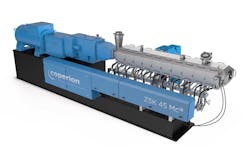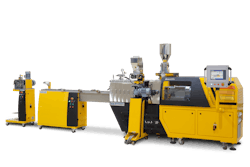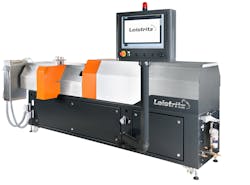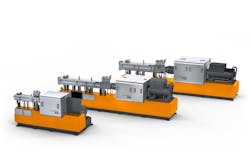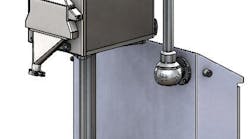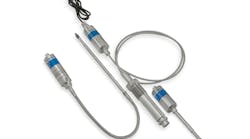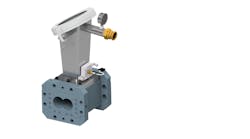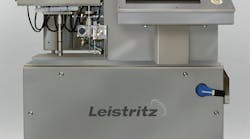Compounding machinery makers have added to their product mixes, with extruders that give users more options in terms of throughputs and L:D ratios. The latest offerings, from Coperion, Labtech Engineering, Leistritz, Brabender and Buss, take on a number of challenging applications and materials, including fillers and recycled resins. At K 2019, manufacturers also demonstrated the latest trends in user interfaces and Industry 4.0 capabilities.
Coperion
Coperion showcased two redesigned ZSK Mc18 compounding extruders with 45mm and 70mm screw diameters and a specific torque of 18 newton meters per cubic centimeter.
They are equipped with a new generation of user-friendly, Industry 4.0-compatible controls that can be individually modified, with user-specific settings, information and simple recipe management integrated into the interface. Smart features include intelligent diagnosis and monitoring functions that can increase productivity and machine availability.
The machines’ upgraded interface is more intuitive to operate, reducing the risk of operator error. It allows operators to monitor factors such as throughput, melt temperature and head pressure at a glance.
To insulate the process section, the extruders come with one-piece covers that can be detached without removing the cartridge heaters. Compared to previous insulation covers, which had three parts and could only be detached by removing the cartridge heaters, the new design is simpler and saves energy.
An additional new convenience is the use of pluggable cartridge heaters that allow efficient temperature control on the inside of the barrel. They are connected using IP67 plugs and can be quickly removed for maintenance.
Another improvement is that the ZSK 45 MC18 is now built in the same way as larger ZSK models, in an effort to make it easier to assemble. Rather than being assembled with tie rods, the ZSK 45 MC18, like its bigger brethren, now is equipped with a barrel with flanges, making disassembly of individual barrels faster.
To further ease maintenance, the lantern gear can be equipped with an electronically secured maintenance opening. As soon as the screw shafts come to a complete stop, service personnel can open the gearbox without tools. This feature reduces downtime.
The redesigned ZSK Mc18 extruders are also suited for recycling applications, according to Peter von Hoffmann, GM of Coperion’s business unit comprising compounding machines, engineering plastics and special applications.
“Along with classic compounding applications, that latest generation of ZSK Mc18 extruders offers clear advantages in many recycling applications as well,” von Hoffmann said. “Operators profit from the gentle operation and very good mixing behavior, even at very high throughput rates. The result is constantly high product quality in compounding and recycling, something that is not always possible with single-screw extruders widely in use on the market.”
The machines can be used to process regrind, including HDPE, PP, ABS, PS, PVC, and PET. High-efficiency homogenization and melt devolatilization reduce odors that might be present in the recycled plastic.
Thanks to their high torque, the machines can process high percentages of fillers such as calcium carbonate, talc, glass or natural fibers efficiently.
Labtech Engineering
Labtech Engineering demonstrated its recently redesigned 26mm MaxiCompounder.
The upgrades include:
• A drive motor that is fully enclosed so that the air from the motor cooling fan enters and exits at the bottom of the extruder body. This ensures that no air is blown over the infeed section of the barrel, keeping dust from building up.
• A high-gloss, stainless-steel barrel cover that has removable sections for each module, which makes it very easy to add one or several side feeders to the barrel.
• Barrel modules that have air gaps between them and are partially insulated from each other, allowing for larger temperature variances between the modules. This feature offers greater flexibility when processing difficult polymers.
The model at the show featured a 26mm screw with a 48:1 L:D ratio, a single side feeder with a gravimetric hopper feeder, an additional gravimetric feeder for the main infeed port and fully computerized controls.
The company is headquartered in Thailand but has four regional U.S. sales agents.
Leistritz
The next generation of Leistritz’s ZSE iMAXX extruder series has a new exterior that includes a closed cover that is smooth and eliminates crevices where pellets and dust could collect.
“Not only the processing unit, but also the side feeder is covered,” managing director Sven Wolf said. “So far, this is unique.”
“The most showy part about this new extrusion line or revamped extruder line is definitely this stainless-steel cover,” said Sebastian Fraas, product and applications manager. “It’s completely covered. It’s a modern design. We have an easy-to-clean surface.”
Leistritz also integrated a TCU in the machine frame.
The ZSE iMAXX also features a quick-change die head that has only two bolts and can be opened safely in a few simple steps, making cleaning and color changes easy. Ideal for small batch sizes, the die head has a short flow channel.
An optional elongational rheometer takes in-line measurements of shear viscosity and elongational viscosity. During extrusion, a small amount of the melt flow enters a bypass system and is pushed through the rheometer’s slot die. After the measurement, the material is transferred back into the process. The measurements can be viewed on the control unit.
The redesigned model is available with screw diameters of 18mm, 27mm, 35mm, 40mm, 50mm and 60mm; Leistritz demonstrated a 27mm model at the show.
Brabender
Brabender’s new TwinLab-C 20/40 laboratory-scale compounding extruder is designed for product development, feasibility studies, material development and analysis of process-dependent material behavior.
It can be used to produce samples for customers and compound samples for mechanical or dynamic testing. Other applications include testing or producing small quantities of new compounds, with or without additives or fillers. It can handle various thermoplastics, engineering resins and thermoplastic elastomers.
The Brabender TwinLab-C 20/40 features a touch-screen control; an integrated frequency-inverter-controlled motor running at either 600 rpm or 1,200 rpm; four top ports and two side ports for dosing raw material and liquids; and four electric heating zones. A large selection of die heads and modular screws is available.
“The twin screw itself is segmented so you can have a library of screw elements for a variety of screw designs,” said Paul Nardone, Brabender’s North American sales manager.
The numbers in the extruder’s name indicate the extruder has a 20mm-diameter screw with a 40:1 L:D ratio. However, tests can be run with different L:D ratios by adjusting a series of plugs along the top of the clamshell barrel. Using the plugs, an operator can create L:D ratios of 10:1, 20:1 or 30:1, Nardone said.
“Some materials don’t like long L:Ds because it creates too much melt and too much shear, so you shorten the length of the barrel to optimize a process,” Nardone said.
Marketing manager James LaPenna said another important feature of the lab extruder is its new integrated software, called MetaBridge.
MetaBridge is easy to use and intuitive, the company said. The software comes ready to use on the extruder. After logging in, a user can find a variety of information and measurements about connected devices. Users can track information from multiple devices simultaneously.
Access to MetaBridge is granted via a password-protected log-in. All Brabender instruments can be interconnected with authorized users, and older Brabender devices can be retrofitted with the MetaBridge controller.
On an extruder, the MetaBridge software can measure such data as material temperature and pressure, load/torque, viscosity and residence time.
Buss
Buss showed off its Compeo 88 and Compeo 110 kneaders. They are available with L:D ratios ranging from 13:1 to 25:1, with the model size indicating the screwTypical throughputs for processing thermoplastics range from about 1,300 pounds to 2,600 pounds per hour for the Compeo 88; and 2,600 pounds to 5,300 pounds per hour for the Compeo 110.
The Compeo 110 on display had an L:D ratio of 18:1. It included a downstream feeder alongside a conical twin-screw discharge unit.
Also on display was a Compeo 88. When designed with an L:D ratio of 25:1, it is optimized for compounding black or color masterbatches. It can be fitted with one or two additional side feeders if required. A European masterbatch manufacturer purchased Buss’ first Compeo 88 and was scheduled to take delivery shortly before the show.
Dino Kudrass, a design and development engineer at Buss, said the modular design of the Compeo compounders allows easy adjustment of the process length, so the equipment can be used for an unusually wide range of applications. Previously, different machines were needed for different types of products. Now, modules from the Compeo line of compounders can be used to process PVC, produce cable compounds and even process food products such as chewing gum, although different configurations might be necessary.
Bruce Geiselman, senior reporter
Contact
Buss Inc. USA, Carol Stream, Ill., 630-933-9100, www.busscorp.com
C.W. Brabender Instruments Inc., South Hackensack, N.J., 201-343-8425, www.cwbrabender.com
Coperion Corp., Sewell, N.J., 856-589-0500 www.coperion.com
Labtech Engineering, Praksa, Thailand, 810-516-1700, http://labtechengineering.com
Leistritz Extrusion, Somerville, N.J., 908-685-2333, www.leistritz.com/en

